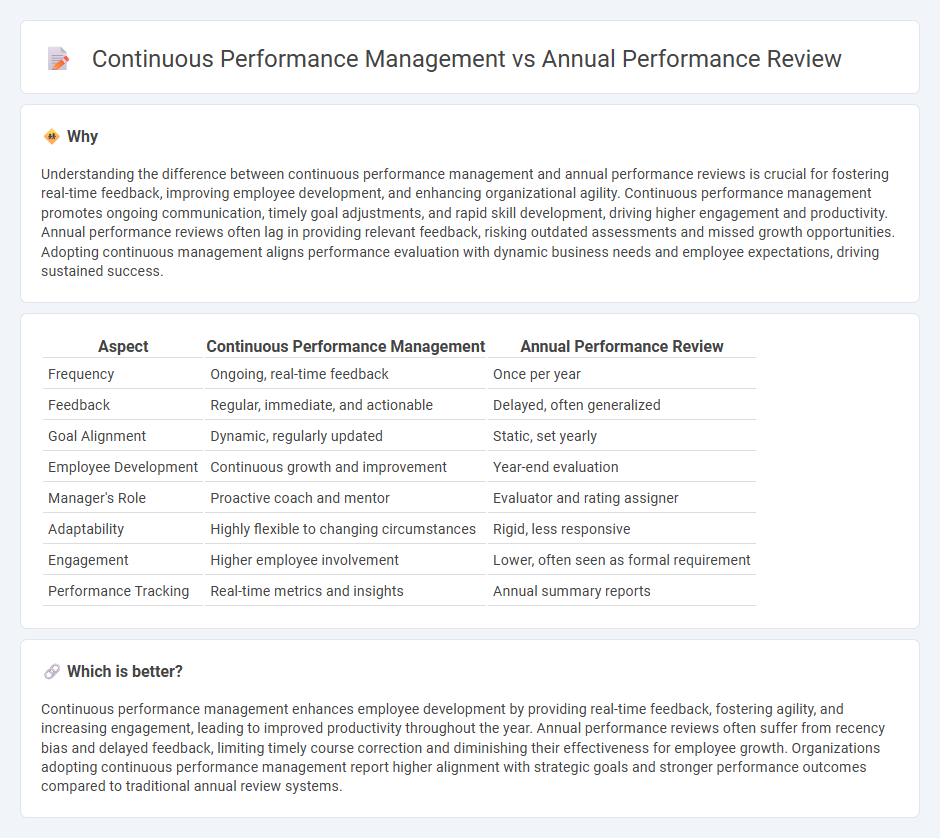
Continuous performance management offers real-time feedback and ongoing development opportunities, enabling employees to adapt and improve consistently throughout the year. In contrast, annual performance reviews provide a retrospective evaluation that may delay recognition and corrective actions. Explore how these approaches impact employee engagement and organizational success.
Why it is important
Understanding the difference between continuous performance management and annual performance reviews is crucial for fostering real-time feedback, improving employee development, and enhancing organizational agility. Continuous performance management promotes ongoing communication, timely goal adjustments, and rapid skill development, driving higher engagement and productivity. Annual performance reviews often lag in providing relevant feedback, risking outdated assessments and missed growth opportunities. Adopting continuous management aligns performance evaluation with dynamic business needs and employee expectations, driving sustained success.
Comparison Table
| Aspect | Continuous Performance Management | Annual Performance Review |
|---|---|---|
| Frequency | Ongoing, real-time feedback | Once per year |
| Feedback | Regular, immediate, and actionable | Delayed, often generalized |
| Goal Alignment | Dynamic, regularly updated | Static, set yearly |
| Employee Development | Continuous growth and improvement | Year-end evaluation |
| Manager's Role | Proactive coach and mentor | Evaluator and rating assigner |
| Adaptability | Highly flexible to changing circumstances | Rigid, less responsive |
| Engagement | Higher employee involvement | Lower, often seen as formal requirement |
| Performance Tracking | Real-time metrics and insights | Annual summary reports |
Which is better?
Continuous performance management enhances employee development by providing real-time feedback, fostering agility, and increasing engagement, leading to improved productivity throughout the year. Annual performance reviews often suffer from recency bias and delayed feedback, limiting timely course correction and diminishing their effectiveness for employee growth. Organizations adopting continuous performance management report higher alignment with strategic goals and stronger performance outcomes compared to traditional annual review systems.
Connection
Continuous performance management provides real-time feedback and development opportunities, creating a dynamic foundation for the annual performance review. This ongoing approach ensures that performance data is accurate, comprehensive, and reflective of current employee contributions, improving the quality and relevance of the annual evaluation. Organizations that integrate continuous performance management with annual reviews enhance employee engagement, goal alignment, and overall productivity.
Key Terms
Feedback frequency
Annual performance reviews typically provide feedback once a year, which can delay addressing performance issues or recognizing achievements in a timely manner. In contrast, continuous performance management emphasizes regular, ongoing feedback, fostering real-time development and enhancing employee engagement. Explore further to understand how shifting feedback frequency impacts organizational success.
Goal setting
Annual performance reviews typically involve setting goals once a year, which can limit real-time adjustments and employee development. Continuous performance management emphasizes ongoing, dynamic goal-setting aligned with business priorities, fostering continuous feedback and adaptability. Explore how continuous goal-setting transforms performance outcomes and enhances employee engagement.
Employee development
Annual performance reviews provide a structured, periodic evaluation of employee achievements and setbacks, while continuous performance management offers ongoing feedback and real-time coaching that drives immediate development. Continuous performance management enhances employee engagement, skill advancement, and goal alignment through frequent check-ins, personalized guidance, and dynamic goal setting. Explore how continuous performance management can transform your employee development strategies and boost overall performance.
Source and External Links
Your Annual Performance Review | UIC Human Resources - The annual performance review is a scheduled meeting between an employee and supervisor that reviews job performance, accomplishments, and progress toward professional development goals over the past year.
Performance Management Evaluations | Human Resources - The annual performance review process enables managers and employees to discuss goals, recognize past challenges and achievements, and plan professional development for the coming year, with set deadlines for evaluations and meetings.
15 Employee Performance Review Templates [2025] - Asana - An annual performance review evaluates a team member's accomplishments and core competencies over one year, fostering transparency and documentation of performance history for goal setting and development discussions.
 dowidth.com
dowidth.com